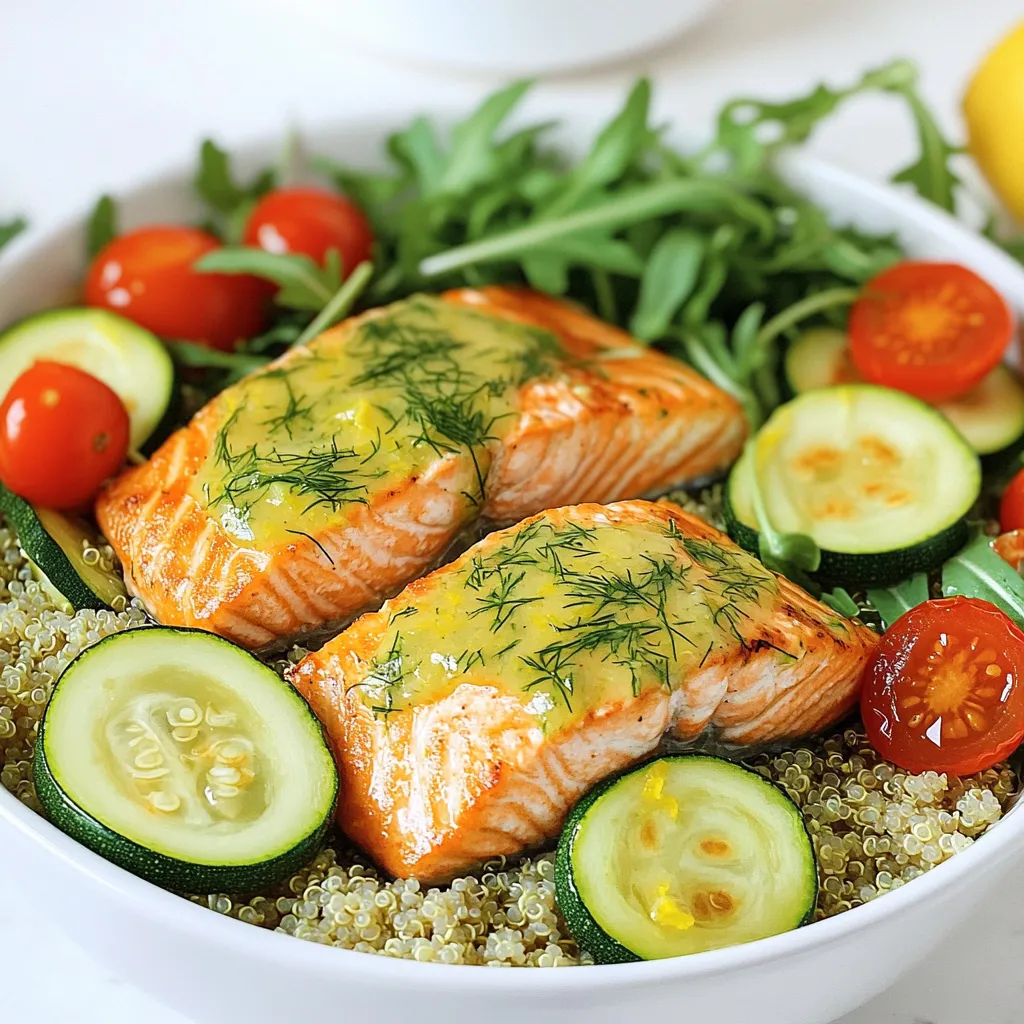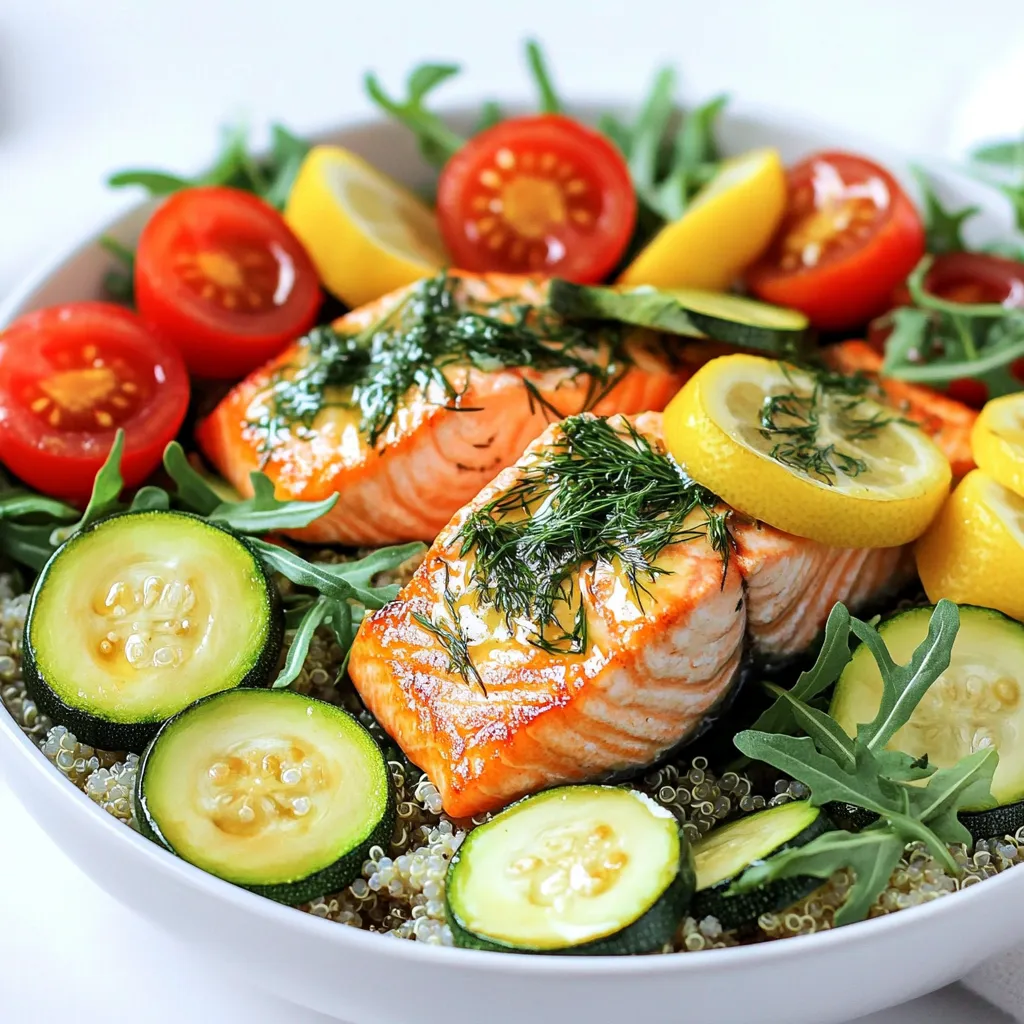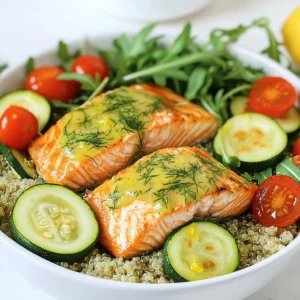Looking for a fresh, simple dish? Let me introduce you to Lemon Dill Salmon Bowls, cooked perfectly on a sheet pan! In just a few easy steps, you’ll have a healthy meal ready for any night of the week. With juicy salmon, tender veggies, and a zesty marinade, this recipe delights the senses. Read on to discover how to make this yummy dish that’s both quick and satisfying!

Ingredients
Salmon and Vegetables
– 4 salmon fillets (approximately 6 oz each)
– 2 medium zucchinis, sliced into half-moons
– 1 cup cherry tomatoes, halved
Marinade Components
– 3 tablespoons extra-virgin olive oil
– Juice of 2 fresh lemons
– Zest of 1 lemon
– 2 tablespoons fresh dill, finely chopped (or 1 tablespoon dried dill)
– 2 cloves garlic, minced
– Sea salt and freshly cracked black pepper, to taste
Serving Options
– 1 cup cooked quinoa
– Handful of fresh arugula or baby spinach for serving (optional)
When I make Lemon Dill Salmon Bowls, I love how fresh and simple the ingredients are. Salmon is packed with protein and omega-3 fatty acids, making it a healthy choice. The zucchinis add a nice crunch, while cherry tomatoes bring sweetness and color.
For the marinade, I combine olive oil, lemon juice, and dill. This blend gives the dish a zesty and bright flavor. I always use fresh lemons because they make a big difference. The garlic adds a punch that rounds out the taste perfectly.
When I serve this dish, I like to add quinoa for a filling base. It’s fluffy and complements the salmon well. Finally, a handful of arugula or spinach adds a fresh touch and a pop of color. This dish is not just tasty; it’s also a feast for the eyes.
Step-by-Step Instructions
Prepping the Ingredients
1. First, preheat your oven to 400°F (200°C). This helps the salmon cook evenly.
2. Line a large baking sheet with parchment paper. This makes cleanup simple later.
3. In a medium bowl, whisk together the marinade. Combine 3 tablespoons of olive oil, the juice of 2 lemons, the zest of 1 lemon, 2 minced garlic cloves, and 2 tablespoons of chopped dill. Add sea salt and black pepper to taste. This zesty mix will bring out the best flavors in your dish.
Arranging the Sheet Pan
1. Place the salmon fillets in the center of the baking sheet.
2. Surround the fillets with sliced zucchinis and halved cherry tomatoes. Spread everything out. This allows each piece to cook properly.
Baking the Dish
1. Drizzle half of the lemon-dill marinade over the fish and veggies. Make sure everything gets a nice coating.
2. Place the baking sheet in your preheated oven. Bake for 15 to 20 minutes. The salmon is done when it flakes easily with a fork and the veggies are tender and golden.
3. While the salmon cooks, reheat your cooked quinoa according to the package instructions. You want it warm and fluffy for the bowls.
Tips & Tricks
Perfectly Baked Salmon
How to tell when salmon is done
To check if salmon is done, look for a few signs. The fish should change from translucent to opaque. When you gently press it with a fork, it should flake easily. The internal temperature should reach 145°F (63°C). A meat thermometer can help ensure it’s cooked properly.
Tips for flaky texture
For a flaky texture, use fresh salmon. Avoid overcooking it, as this can dry it out. Let the salmon rest for a few minutes after baking. This allows the juices to settle, giving you a moist bite.
Vegetable Cooking Tips
Ensuring even cooking
Cut the vegetables into uniform sizes. This helps them cook evenly. Spread them out on the baking sheet. Overcrowding can lead to steaming instead of roasting.
Alternative vegetable options
If you want to switch it up, try asparagus or bell peppers. Broccoli or green beans also work well. These alternatives add different flavors and textures.
Marinade Tips
Adjusting flavors to taste
Feel free to tweak the marinade. If you like it zestier, add more lemon juice or zest. For extra flavor, mix in some mustard or honey.
Suggested add-ins for extra zest
Add red pepper flakes for heat or capers for brininess. Fresh herbs like parsley or basil can also enhance the taste. Mix and match to find your favorite combination!

Variations
Ingredient Swaps
You can switch up the fish in this recipe. Try trout, tilapia, or a firm white fish. Each one brings a unique flavor. If you want a non-fish option, consider chicken or tofu. Both options work well with the lemon-dill sauce.
For the grain, you can swap quinoa with rice or couscous. Brown rice gives a nutty taste. Couscous offers a fluffy texture that complements the salmon. Feel free to use what you have on hand.
Flavor Enhancements
To make your dish pop, add more spices or herbs. A pinch of paprika gives a nice kick. You can also mix in fresh parsley or chives for extra flavor. If you’re a fan of heat, try adding red pepper flakes.
For a citrus twist, use lime or orange juice instead of lemon. Each option brings a bright, fresh taste. You could even try a mix of citrus juices for a zesty surprise.
Serving Suggestions
Pair your salmon bowls with different sides for variety. A simple green salad adds crunch. Roasted sweet potatoes or steamed broccoli also work well. Each side enhances the flavor of the salmon.
When assembling your bowls, think outside the box. Layer the quinoa, then add the salmon. Top with roasted veggies and a handful of fresh greens. Drizzle extra lemon-dill sauce on top for a burst of flavor. You can also use avocado slices for creaminess.
Storage Info
Refrigerating Leftovers
To store your lemon dill salmon bowls, let them cool first. Place the salmon, veggies, and quinoa in airtight containers. This helps keep them fresh and tasty. You can store them in the fridge for up to three days. After that, the flavor and texture may change.
Reheating Instructions
When it’s time to enjoy your leftovers, use the oven or microwave. For the oven, set it to 350°F (175°C). Place the salmon and veggies on a baking sheet. Heat for about 10-15 minutes. This keeps them moist and avoids drying out. If using a microwave, cover the bowl with a damp paper towel. Heat for 1-2 minutes. This method helps keep the salmon juicy.
Freezing Options
Yes, you can freeze salmon bowls! Wrap each portion tightly in plastic wrap and then foil. This protects them from freezer burn. They can last up to three months. When ready to eat, thaw them overnight in the fridge. Reheat using the oven or microwave as mentioned before. This way, you maintain the flavor and texture of your meal.
FAQs
How long does it take to cook salmon at 400°F?
The ideal cooking time for salmon at 400°F is 15 to 20 minutes. This time allows the salmon to cook evenly. It should flake easily with a fork when done. The vegetables around the salmon will also become tender. Always check the thickest part of the salmon for doneness.
Can I use frozen salmon fillets?
Yes, you can use frozen salmon fillets. Just add a few extra minutes to your cooking time. Make sure to check the salmon for doneness as it cooks. If you want, thaw the fillets overnight in the fridge for even cooking. However, cooking from frozen is easy and saves time.
What can I substitute for fresh dill?
If you don’t have fresh dill, use dried dill instead. You can use one tablespoon of dried dill for every two tablespoons of fresh dill. Other good options include parsley or tarragon for a different flavor. Each herb brings a unique taste that can enhance your dish.
This dish combines healthy salmon, veggies, and a tasty marinade. You learned how to prepare it step-by-step, with tips to ensure perfect cooking. Don’t forget the fun variations and storage ideas to keep meals fresh. Whether for a quick dinner or meal prep, this recipe works well. Enjoy your tasty, nutritious salmon bowl, and feel free to share with friends!


